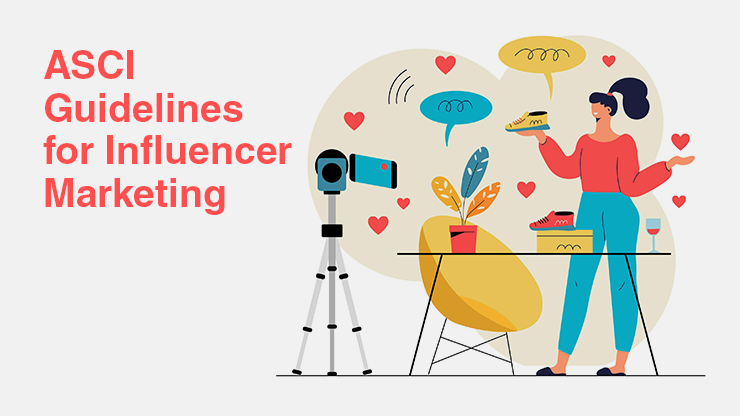The Influencer Marketing industry is rising exponentially and it was only a matter of time before it got its own set of official guidelines. The Advertising Standards Council of India (ASCI) has made it mandatory for every online influencer to label the promotional content they post, effective for every content published on or after 14th June 2021.
The guidelines, earlier issued in February, received feedback from all stakeholders, including advertisers, influencers, and market specialists. ASCI brought in leading industry experts and social media agencies together to weigh in on the guidelines, which will apply to all commercial messages or advertisements. As per the guidelines, every digital media influencer has to include a disclosure label on their content, be it images, videos, or text. Let us have a look at the guidelines and the reaction of the industry.
The Advertising Standards Council of India (ASCI) has made it mandatory for every online influencer to label the promotional content they post, effective for every content published on or after 14th June 2021. Click To Tweet
What are the guidelines?
The new guidelines issued by ASCI help social media users identify paid content by mandating that every social media influencer makes a visible declaration about the content they post.
The new guidelines define the material connection between an advertiser and an influencer as any connection that may affect the credibility of the representation, and that could include benefits and incentives not limited to monetary compensations. Simply speaking, the guidelines aim for one big purpose – to specify a distinct line between organic content and advertisements. To do so, the guidelines state that the disclosure about the brand content must be easily visible for a certain duration of time (for videos), should be visible without scrolling (for titles and descriptions), and must be translated into the local language of the advertisement (if not English).
According to ASCI, all advertisements published by social media influencers or their representatives, on such influencers' accounts must carry a disclosure label that clearly identifies it as an advertisement. Click To Tweet
For the disclosure labels, ASCI has specified several keywords such as Advertisement, Ad, Sponsored, Collaboration, Partnership, Employee and Free gift. Any or more of these disclosures can be used while intimating the user of the promotional content. Here’s a simplified look at the guidelines for some famous social media channels:
If the advertisement is only a picture with no textual content, a disclosure label needs to be added above the image so that it is clearly visible. If textual content is provided, the disclaimer label should be placed in a way that it is not missed by an average user. It should also not be buried under a group of hashtags or subjected to ‘click more’.
The disclosure label should be included in the title of the post/video. It should not be placed in the ABOUT ME section, profile page, bios, or anywhere that requires the user to click more. If there’s no title or any kind of textual content, the disclaimer label must be on the video/image, same as Instagram.
If the advertisement is only a picture with no textual content, Instagram influencers need to add a disclosure label above the image so that it is clearly visible, says ASCI. Click To Tweet
YouTube (and other vlogging channels)
The disclosure label should be included in the title/description of the post. Similar to Facebook, it should not be hidden in any manner. It should not require another click from the user and neither should it be buried under a group of hashtags, same as Instagram. For live streams, the disclosure label should be announced at the beginning and the end of the broadcast. In addition to all this, influencers should also use the platform’s disclosure tool.
The disclosure label is to be included at the beginning of the message. For any textual content, the same guideline is to be followed as for Instagram, Facebook and YouTube. Twitter: Include the disclosure label at the beginning of the tweet. Using the specified keywords visibly as hashtags (disclosure label should not be hidden under a group of hashtags).
Include the disclosure label at the beginning of the tweet using the specified keywords visibly as hashtags (disclosure label should not be hidden under a group of hashtags).
Why the need for guidelines?
As mentioned in a dedicated page of the guidelines, the lines between organic content and paid advertisements are blurring.
In an interview to Quint, Manisha Kapoor, Secretary General, ASCI, said, “We thought this was a good time to look at the way on how this spectrum needs to be regulated because lines between advertising and content are now blurring on social media platforms”.
ASCI believes that social media users have a right to know all about the type of content they consume. It believes that a customer’s choice for a certain product must be because of their interest in the product or its advertisement and not because of misleading content by a social media influencer. Thus, the ASCI has crafted a guideline keeping all the industry stakeholders in mind.

Who identifies the defaulters?
When it comes to implementation, ASCI will be monitoring potential violations with the help of Artificial Intelligence from French technology provider Reech. As per the official statement. “The Reech Influence Cloud platform uses Artificial Intelligence to identify lack of disclosure on posts of a commercial nature on social media.”
ASCI further stated that the disclosure of the connection and the advertisement is upon the advertiser. In case of a complaint, the company can ask the influencer to change or remove an advertisement.
How is the Industry reacting?
Many digital media experts are saying that since the industry was on an exponential rise, it was only natural that regulations would be put in place. Let’s take a look at the different reactions coming in about the ASCI guidelines.
“Regulations and guidelines are important in every growing industry. A lot of stakeholders might not be very happy and have their concerns but I feel this is important for the ecosystem to grow. These regulations will play an important role in the briefs that brands and agencies create for influencers. The transparency will force them to allow influencers to be more creative rather than focus on “hard selling” content.” – Amev Burman, CEO & Co-founder, Adfluence Hub
I believe that these guidelines, in the long run, will allow existing and budding content creators (who are not yet categorized as influencers) to monetize their content and grow the sector.” – Neena Dasgupta, CEO & Director at Zirca Digital Solutions
“There might be some teething issues initially, but this will be a great step and will be beneficial for all in the long run.” – Manesh Swamy, Vice President-Creative, Logicserve Digital
However, others are hesitant, fearing that the guidelines could make the whole Industry bureaucratic and restrict the growth of influencers.
“For brand marketers, the process of dealing with influencers will become very cumbersome and bureaucratic, which is opposed to why influencer marketing became a preferred option. Else brands would have gone to celebrities or sports stars.” – Smita Murarka, Vice-President, Marketing and E-commerce, Duroflex
The new ASCI guidelines aim for one big purpose - to specify a distinct line between organic content and advertisements. They will also hold advertisers accountable for their ads, giving young influencers more chance to grow. Click To Tweet
With the exponential growth that the Influencer Marketing industry has seen in the last decade, a guideline of this sort was almost imminent. Thoroughly discussed and vetted as they are, these guidelines are likely to bring many benefits to all the stakeholders of the Industry. Furthermore, these regulations will also hold advertisers accountable for their ads, giving young influencers a chance to grow. It will also draw a fine line between organic content and promotional ads. However, we believe that as the policy begins to be implemented, the shortcomings and the benefits will become more evident, paving a path on which ASCI can amend and regulate the guidelines in the future.













